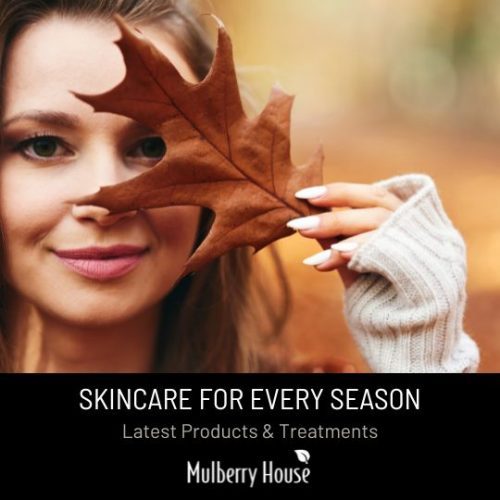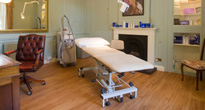Preparing Your Skin

How Cooler Temperatures Affect the Skin
During autumn and winter, the air becomes drier and colder. This can strip the skin of its natural oils, leading to dryness, flakiness, and irritation. It can be quite a sudden shift too and skin can struggle to adapt.
Indoor heating, while comforting, can further dehydrate your skin, causing tightness and a dull appearance. For those with sensitive skin, these environmental changes can trigger redness or exacerbate conditions like eczema.
Essential Skincare Adjustments for the Colder Months
- Switch to a Richer Moisturiser
Lightweight summer moisturisers may no longer provide enough hydration. Opt for creams or balms with nourishing ingredients such as hyaluronic acid, shea butter, or ceramides to lock in moisture. - Hydrating Serums are Your Friend
Incorporate hydrating serums containing hyaluronic acid or glycerin under your moisturiser to help maintain skin hydration throughout the day. - Gentle Cleansing
Avoid harsh, stripping cleansers that can worsen dryness. Choose gentle, cream-based cleansers that remove impurities without compromising your skin’s natural barrier. - Exfoliation with Care
While exfoliation is important, reduce its frequency during colder months to prevent over-drying. Gentle chemical exfoliants like lactic acid can help remove dead skin cells without irritating sensitive skin. - Sun Protection Still Matters
Even in winter, UV rays can damage the skin and accelerate ageing. Continue using a broad-spectrum SPF daily, especially if spending time outdoors.
The Benefits of Doctor-Led Skincare and Medical-Grade Products
When it comes to protecting and improving your skin during the colder months, not all products are created equal. Doctor-led skincare and cosmeceutical or medical-grade products offer unique benefits that go beyond over-the-counter options:
- Personalised Assessment and Guidance
A doctor or qualified clinician can assess your skin type, identify underlying concerns, and recommend products or treatments tailored specifically to your needs. This personalised approach ensures your skin gets exactly what it requires, avoiding trial-and-error that can sometimes cause irritation or exacerbate issues. - Potent Ingredients for Visible Results
Medical-grade products contain higher concentrations of active ingredients—such as retinoids, peptides, antioxidants, and growth factors—than standard over-the-counter skincare. This means they can deliver more significant improvements in hydration, texture, pigmentation, and overall skin health. - Safety and Efficacy
Products recommended in a clinical setting are rigorously tested for safety and effectiveness. Clinician supervision ensures that potent ingredients are used in a way that maximises benefits while minimising risks, particularly important for sensitive or reactive skin. - Complementing Professional Treatments
Doctor-led skincare is designed to work alongside clinical procedures such as chemical peels, microneedling, or radiofrequency treatments. This synergy enhances results, helps maintain treatment outcomes, and accelerates skin recovery, particularly during the drier autumn and winter months. - Education and Long-Term Skin Health
Beyond recommending products, clinicians educate patients on how to use them correctly, how to layer active ingredients safely, and how to adjust routines with changing seasons. This guidance supports sustained skin health and helps prevent common issues like dryness, irritation, or premature ageing.
Treatments to Boost Skin During Autumn
Autumn is the perfect time to refresh your skin after summer and prepare it for the colder, drier months ahead. Professional treatments can restore hydration, improve texture, and strengthen the skin’s natural barrier. Here are some of the most effective options:
- Microdermabrasion
Microdermabrasion is a non-invasive exfoliation treatment that removes dead skin cells and stimulates circulation. It helps brighten dull complexions, improve texture, and prepare the skin to better absorb serums and moisturisers. Autumn is an ideal time for microdermabrasion as the sun is less intense, reducing the risk of post-treatment sensitivity. - Microneedling
Microneedling uses tiny, controlled micro-injuries to stimulate collagen and elastin production. It improves skin texture, firmness, and tone, while also enhancing the absorption of skincare products applied afterward. This treatment is particularly beneficial in autumn when the skin is less exposed to harsh UV rays. - Ultherapy
Ultherapy is a non-surgical, ultrasound-based treatment that lifts and tightens the skin by stimulating collagen production deep within the layers of the skin. It’s perfect for restoring firmness and improving facial contours, helping your skin maintain a youthful, resilient appearance as temperatures drop. - Tixel
Tixel is an advanced thermo-mechanical skin rejuvenation treatment that uses controlled heat to stimulate collagen and improve skin texture. It can target fine lines, mild scarring, and uneven skin tone while boosting overall radiance. Tixel’s gentle approach makes it suitable for sensitive skin and the cooler months, when the skin barrier is more vulnerable. - Chemical Peels
Chemical peels remove dead skin cells, brighten the complexion, and improve overall skin tone. In autumn, milder peels or hydration-focused formulas are recommended to rejuvenate the skin without causing excessive sensitivity to the environment. - LED Light Therapy
LED therapy is a non-invasive treatment that calms inflammation, promotes collagen production, and accelerates skin repair. Red and near-infrared light are especially beneficial for hydration, firmness, and overall skin rejuvenation during the drier autumn months.
A good clinician will understand how best to use or combine these treatments in a personalised plan tailored to your skin type and concerns. This approach ensures optimal hydration, improved texture, and a radiant complexion, helping your skin transition smoothly into winter.
Conclusion
Autumn and winter require a proactive approach to skincare. By adapting your routine, debunking common myths, and incorporating professional treatments when needed, you can protect your skin from dryness, irritation, and premature ageing, ensuring it stays healthy, radiant, and comfortable throughout the colder months.
Mulberry House Clinic
Established 2003
Mulberry House Clinic has an excellent reputation in the Northampton area as an independent, doctor-led practice with vast experience of the industry. Cosmetic skin treatments are carried out by Dr John Tanqueray, who works closely with leading manufacturers to remain at the forefront of the medical aesthetics.
For further information or to arrange a confidential consultation, please complete our contact form, call 01604 702630 or email: info@mulberryhouseclinic.co.uk.







